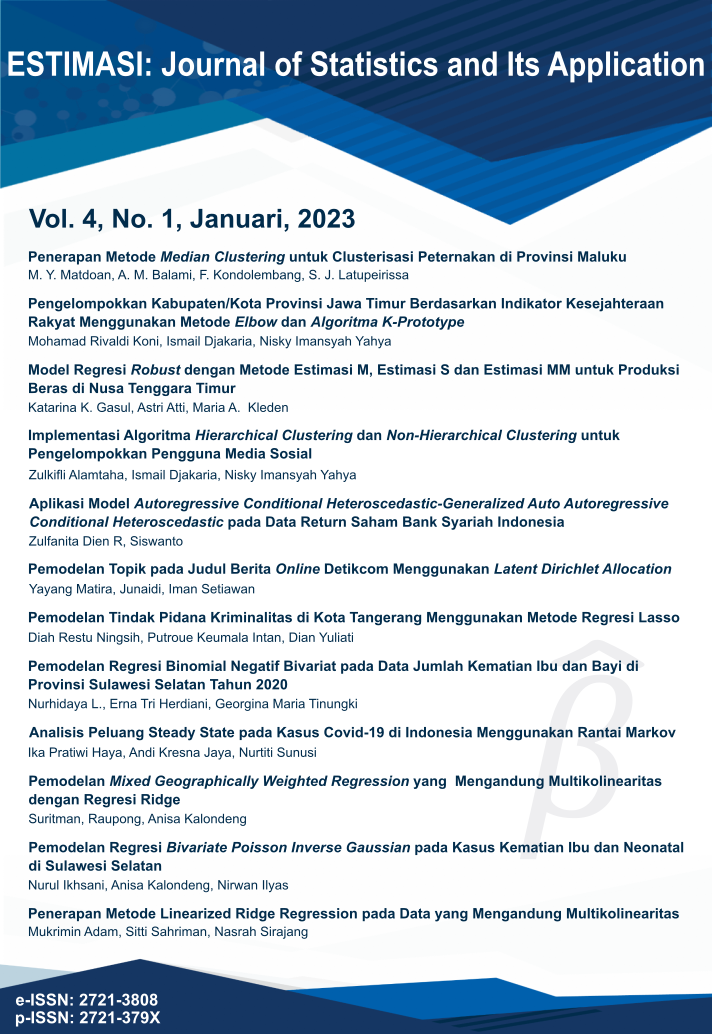Pemodelan Tindak Pidana Kriminalitas di Kota Tangerang Menggunakan Metode Regresi Lasso
DOI:
https://doi.org/10.20956/ejsa.vi.24853Keywords:
Crime, criminality, lasso regressionAbstract
Criminal acts are one indicator of social welfare for a sense of security. The higher the reporting of criminal cases by the public, it indicates that the level of security in the area is getting worse. Crime acts in Tangerang City can be influenced by several factors, namely the poverty factor, the population factor and the population growth rate factor. If the rate of population growth experiences rapid growth, the population will increase and it is undeniable that poverty will increase in the city of Tangerang. This can trigger criminal acts to meet unsatisfied needs. The purpose of this study is to determine the variables that influence criminal acts in Tangerang City and to overcome the variables that occur multicollinearity. It can be concluded that all variables influence crime and the LASSO (Least Absolute Shrinkage And Selection Operator) regression can simplify the model and indirectly overcome the problem of multicollinearity in this study. So that the government can make more efforts to overcome the population and poverty problems that occur and the police to increase security in the City of Tangerang in order to create even better security and minimize crime.
References
R. M. Sabiq dan N. C. Apsari, “Dampak Pengangguran Terhadap Tindakan Kriminal Ditinjau dari Perspektif Konflik,” J. Kolaborasi Resolusi Konflik, vol. 3, no. 1, hal. 51, 2021, doi: 10.24198/jkrk.v3i1.31973.
Irma Suciaty Shahar, “Analisis Determinan yang Mempengaruhi Kriminalitas Provinsi Lampung Tahun 2009-2015,” hal. 14–43, 2019.
F. Prabowo, Y. Wilandari, dan A. Rusgiyono, “Pemodelan pertumbuhan ekonomi Jawa Tengah menggunakan pendekatan least absolute shrinkage and selection operator (Lasso),” J. Gaussian, vol. 4, no. 4, hal. 855–864, 2015.
R. Tibshirani, “Regression Shrinkage and Selection Via the Lasso,” J. R. Stat. Soc. Ser. B, vol. 58, no. 1, hal. 267–288, 1996, doi: 10.1111/j.2517-6161.1996.tb02080.x.
R. M. Sabiq dan N. Nurwati, “Pengaruh Kepadatan Penduduk Terhadap Tindakan Kriminal,” J. Kolaborasi Resolusi Konflik, vol. 3, no. 2, hal. 161, 2021, doi: 10.24198/jkrk.v3i2.35149.
R. M. Sabiq, N. Nurwati, M. Dulkhan, dan Nurjanah, “Pengaruh kemiskinan terhadap tingkat tindak kriminalitas di kota bandung,” J. Kolaborasi Resolusi Konflik, vol. 8, no. 1, hal. 161, 2018, doi: 10.24198/jkrk.v3i2.35149.
A. Oktiani, “Pengaruh Jumlah Penduduk dan Inflasi Terhadap Pendapatan Asli Daerah (PAD),” J. Ilmu Ekon. dan Pembang., vol. 1, no. 1, hal. 16–35, 2021.
W. Mayasari, “Pengaruh Tingkat Kesehatan, Jumlah Penduduk dan Tingkat Pendidikan Terhadap Kemiskinan di Kabupaten Tanggamus dalam Perspektif Ekonomi Islam Tahun 2009-2018,” skripsi, 2019.
N. Suhandi, E. A. K. Putri, dan S. Agnisa, “Analisis Pengaruh Jumlah Penduduk terhadap Jumlah Kemiskinan Menggunakan Metode Regresi Linear di Kota Palembang,” J. Ilm. Inform. Glob., vol. 9, no. 2, hal. 77–82, 2018, doi: 10.36982/jig.v9i2.543.
D. Mahsunah, “Analisis Pengaruh Jumlah Penduduk, Pendidikan dan Pengangguran Terhadap Kemiskinan di Jawa Timur,” J. Pendidik. Ekon., vol. 1, no. 3, hal. 1–17, 2013.
D. Ningsih dan P. Andiny, “Analisis Pengaruh Inflasi dan Pertumbuhan Ekonomi Terhadap Kemiskinan di Indonesia Desrini,” JABE (Journal Appl. Bus. Econ., vol. 7, no. 2, hal. 271, 2021, doi: 10.30998/jabe.v7i2.7653.
I. Rahma, “Penerapan Teori dan Kebijakan Kriminal dalam Pertimbangan Hukum dalam Sistem Peradilan Pidana,” Vol. X1, hal. 51–70, 2018.
Irmawati, “Peran Kepolisian dalam Menanggulangi Tindakan Kejahatan Pencurian yang Dilakukan oleh Anak Dibawah Umur Dipolsek,” no. 1461040024, 2019.
N. A. Bahmid, “Metode Least Absolute Shrinkage and Selection Operator untuk Mengatasi Multikolinearitas pada Regresi Logistik Ordinal,” no. November, 2018.
I. Sartika, N. N. Debataraja, dan N. Imro’ah, “Analisis Regresi dengan Metode Least Absolute Shrinkage and Selection Operator (Lasso) dalam Mengatasi Multikolinearitas,” Bimaster Bul. Ilm. Mat. Stat. dan Ter., vol. 9, no. 1, hal. 31–38, 2020, doi: 10.26418/bbimst.v9i1.38029.
J. S. Clark, Model Assessment and Selection. 2020. doi: 10.2307/j.ctv15r5dgv.9.
M. Robbani, F. Agustiani, dan N. Herrhyanto, “Regresi Least Absolute Shrinkage and Selection Operator (Lasso) pada Kasus Inflasi di Indonesia Tahun 2014-2017,” EurekaMatika, hal. 1–16, 2019.
T. T. Pardede, B. Sumargo, dan W. Rahayu, “Penerapan Regresi Least Absolute Shrinkage and Selection Operator (LASSO) untuk Mengidentifikasi Variabel yang Berpengaruh Terhadap Kejadian Stunting di Indonesia,” J. Stat. dan Apl., vol. 6, no. 1, hal. 37–48, 2022, doi: 10.21009/jsa.06104.
Downloads
Published
Issue
Section
License
Copyright
It is the author's responsibility to ensure that his or her submitted work does not infringe any existing copyright. Authors should obtain permission to reproduce or adapt copyrighted material and provide evidence of approval upon submitting the final version of a manuscript.


